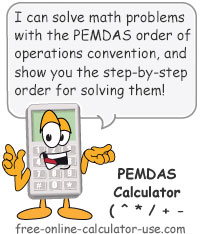IMPORTANT: Numeric entry fields must not contain dollar signs, percent signs, commas, spaces, etc. (only digits 0-9 and decimal points are allowed).
Click the Terms tab above for a more detailed description of each entry.
Instructions for Use
Enter or select a math problem to solve.
If entering a math problem, use only the following list of valid non-numeric characters:
- ( ) [ ] { } (all will be converted to ())
- ^ for exponents (enter 34 as 3^4)
- * for multiplication (x will be converted to *)
- / for division (÷ will be converted to /)
- + for addition
- - for subtraction
For entering numeric characters, be sure to insert a zero before any number that begins with a decimal point (for .5, enter 0.5).



Follow me on any of the social media sites below and be among the first to get a sneak peek at the newest and coolest calculators that are being added or updated each month.